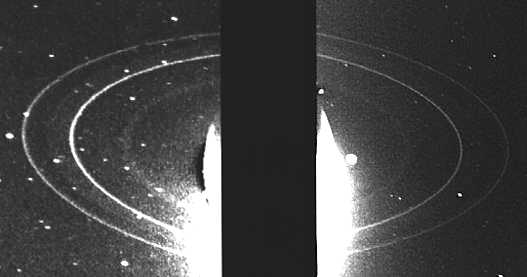 |
The Planet Quiz Show |
 |
Answer:
Jupiter (5 rings), Saturn (7 major ring systems, totaling in excess of 100,000 individual rings and at least a half dozen minor rings), Uranus (12 rings), Neptune (6 rings).
For Teachers:
Ring systems may be the result of leftover debris that never fell to the planetís surface from the planetís original formation, or from the breakup of moons which ventured too close to the planetís strong gravitational field.
| Jupiter has the wimpiest ring system of any planet in the solar system. The rings are composed of very small dust particles which are knocked off two of Jupiterís inner moons by small pieces of dust (micrometeorites) striking their surfaces. NASA/JPL photo... |
| The Galileo spacecraft looks at Jupiter's thin Main Ring nearly edge on. The fuzziness on the inside of the Main Ring is caused by dust in the Halo Ring. The Halo Ring extends right to the cloud tops of Jupiter. On the inward and outward sides of Jupiterís Main Ring can be found two very small satellites, Metis at 79,521 miles from Jupiter's cloud tops and Adrastea at 80,144 miles above Jupiter. These small moons are not visible in the photograph. The gravity from these moons helps to trap the dust in the Main Ring for a longer period of time. Jupiter is to the far right in this NASA/JPL photo. |
|
Saturnís seven rings are composed mainly of ice and dirty ice particles. They range in size from microscopic grains to objects that would be as large as a classroom. The gaps in Saturnís rings are caused by the gravitational tugs and pulls of Saturnís moons moving ring particles away from these regions. Hubble Space Telescope photo...
|
| Uranusí dozen rings are composed of rocky material like Jupiterís ring. However, like Saturnís rings, Uranusí rocky ring material ranges in size from dust to 30 feet in diameter. The brightest ring, near the top of the photograph, is called the Epsilon ring. Uranusí ring system was discovered from the Earth in 1977. |
| Neptune has six rings, four of which are visible in this photo. They are probably composed of dust and rock. The outermost ring is called Adams after the English astronomer, John Couch Adams who predicted mathematically Neptune's position in the sky. At the same time a French astronomer, Urbain Leverrier made the same calculation independent of Adams. Leverrier made his findings available to J.G. Galle of the Berlin Observatory (Germany). Galle made the discovery in 1846 on the first night that he was looking for Leverrier's planet. To repeat, the outer ring is Adams. The next ring, which is very fuzzy, has not been named. Next comes bright Leverrier. The broad fuzzy ring closest to Neptune is called Galle. Now you know where these ring names came from. The planet Neptune in this Voyager 2 image has been blocked by a bar so that its reflected light does not wash out the detail of the rings. NASA/JPL photo... |
Back to the questions!


![[Hubble views Saturn and its rings]](9c.jpg)

